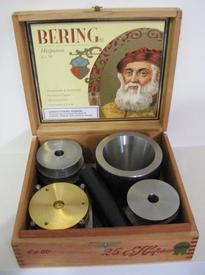Making the Case for My Watch
This section is to describe the making of the case for the watch. At the current date, this is a premature subject, since the movement is far from complete. However, if you are following along on this journey, you will notice that I tend to jump around as I please...
Daniels provides a very thorough account of his methods of making a case. Another excellent reference is Steffan Pahlow's "Das Klassische Taschenuhrgehäuse," although originally written in German, it is the only other text I have found which deals with the subject of casemaking. These methods draw heavily on traditional goldsmithing techniques. As I mention in the Introduction section, one must learn many different skills to make a watch in its entirety. Gold/silversmithing methods differ somewhat from other watchmaking tasks, which generally fall into the realm of the machinist. The case making process includes such tasks as forming, forging, drawing, bezel making, casting, hingemaking, chainmaking, and soldering.
Given the high cost of gold I decided to use silver, which as far as fabrication goes, behaves in much the same way as gold and more importantly, is available at a small fraction of the cost. Although there are very few photographs where it is apparent, Daniels' first watch was made from both silver and gold.
I will be using "Sterling" silver, which is typically a silver-copper alloy (92.5% : 7.5%), hence the usual hallmarking stamp of "925." Sterling silver is commonly used in preference to purer forms of silver since it offers more durability compared to fine (99.9%) silver. Since I currently lack a rolling mill or similar types of equipment for modifying the dimensions of stock material, I will attempt to construct the case starting with standard dimensions of silver wire that are stocked by jeweler supply shops and metal refiners.
Daniels provides a very thorough account of his methods of making a case. Another excellent reference is Steffan Pahlow's "Das Klassische Taschenuhrgehäuse," although originally written in German, it is the only other text I have found which deals with the subject of casemaking. These methods draw heavily on traditional goldsmithing techniques. As I mention in the Introduction section, one must learn many different skills to make a watch in its entirety. Gold/silversmithing methods differ somewhat from other watchmaking tasks, which generally fall into the realm of the machinist. The case making process includes such tasks as forming, forging, drawing, bezel making, casting, hingemaking, chainmaking, and soldering.
Given the high cost of gold I decided to use silver, which as far as fabrication goes, behaves in much the same way as gold and more importantly, is available at a small fraction of the cost. Although there are very few photographs where it is apparent, Daniels' first watch was made from both silver and gold.
I will be using "Sterling" silver, which is typically a silver-copper alloy (92.5% : 7.5%), hence the usual hallmarking stamp of "925." Sterling silver is commonly used in preference to purer forms of silver since it offers more durability compared to fine (99.9%) silver. Since I currently lack a rolling mill or similar types of equipment for modifying the dimensions of stock material, I will attempt to construct the case starting with standard dimensions of silver wire that are stocked by jeweler supply shops and metal refiners.
I started with the chain very early on, primarily because it seemed like a fun project, and it offers lots of practice with soldering. I provide some details in the subsection on making the chain on soldering methods and the tools I used.

